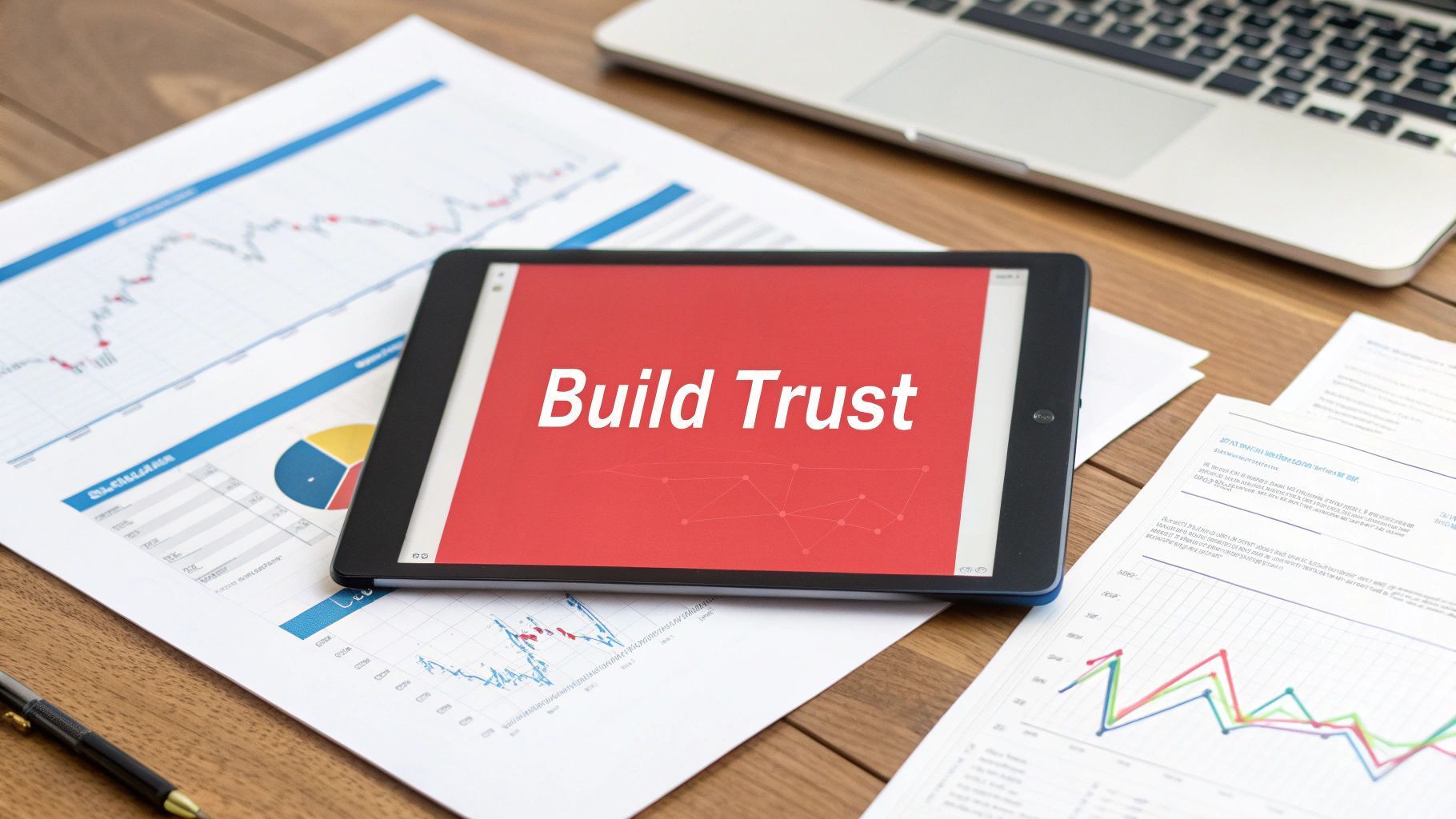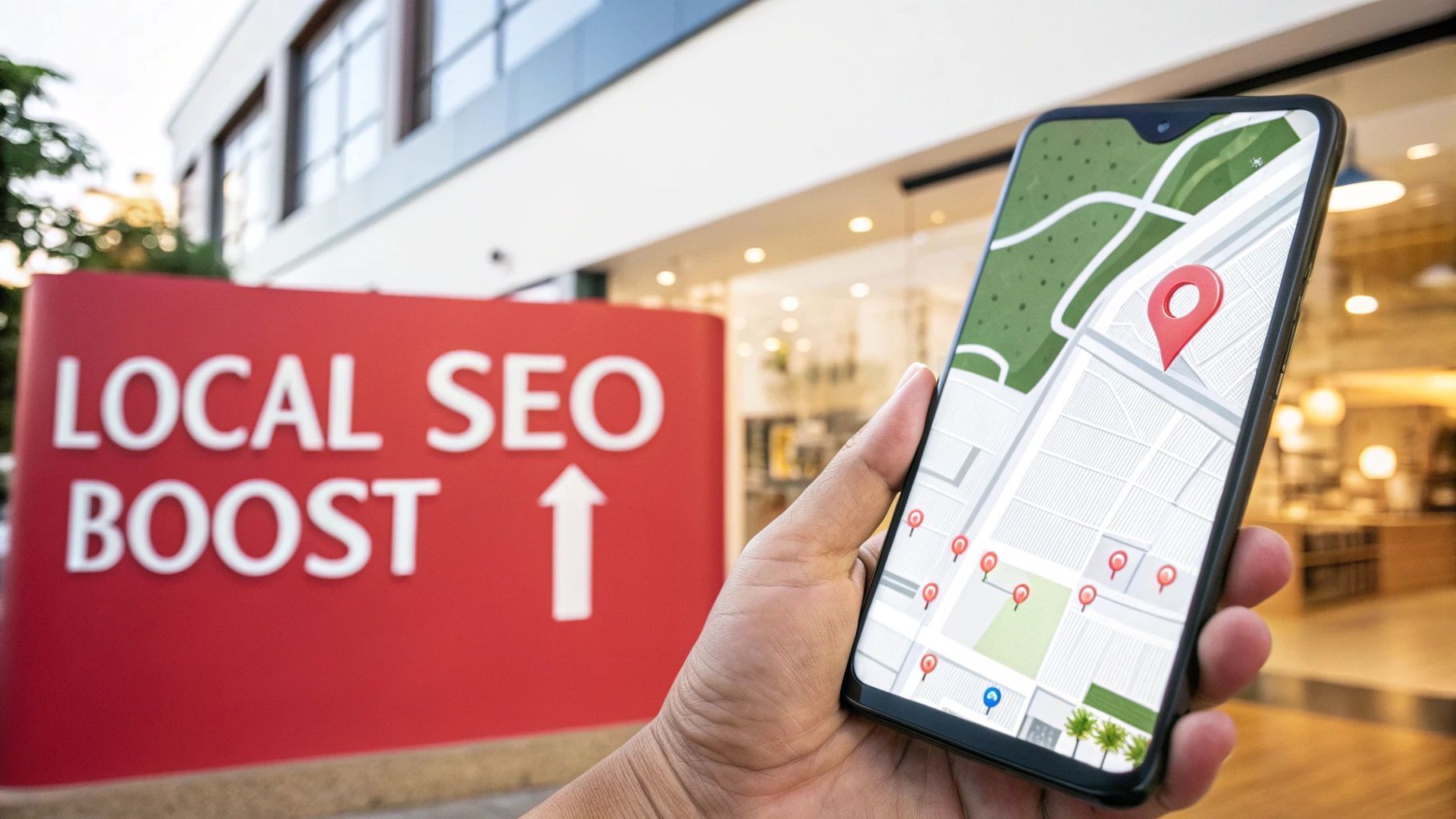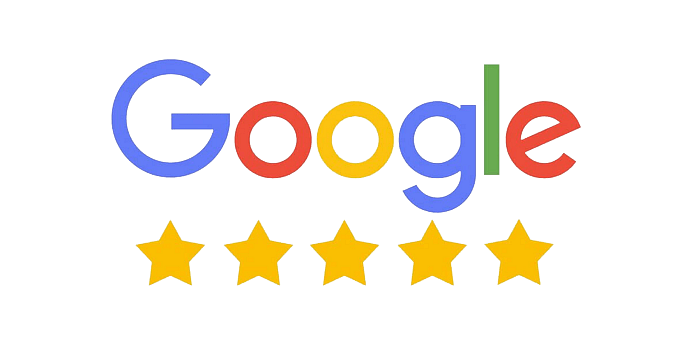Social Media Management for Businesses Done Right
Social media management for businesses is all about creating, publishing and analysing content on social platforms to hit real commercial goals. It's a strategic game that goes way beyond just posting updates. The focus is on building a genuine brand presence, connecting with the right people and driving tangible results like leads and sales.
Building Your Social Media Foundation
Just jumping onto social media without a plan is a classic recipe for wasted time and effort. A strong foundation is what turns random posts into a strategy that actually gets results. Effective social media management isn't about chasing vanity metrics; it’s about making sure every single post, reply and campaign connects back to a measurable business objective.
This means you have to move past vague goals like ‘getting more followers’. Instead, you need to lock in clear, specific outcomes that really matter to your bottom line.
Define Your Business Objectives
Before you even think about what to post, you need to be crystal clear on why you're using social media in the first place. Are you trying to boost brand awareness in a new market? Is the main goal to generate qualified leads for your sales team? Or maybe you want to build a loyal community to keep your customers coming back.
Each of these goals demands a completely different approach.
- Driving Website Traffic: Your content will need strong calls-to-action that make people want to click, usually sending them to blog posts or product pages.
- Generating Leads: This might involve promoting gated content like webinars or eBooks that ask for an email sign-up.
- Boosting Customer Loyalty: Here, your energy would go into community engagement, sharing user-generated content and being super responsive to customer queries.
Putting together a solid social media marketing plan is the essential first step. It forces you to think strategically right from the start.
Key Takeaway: Your social media goals should directly back up your wider business objectives. If a social media task doesn't contribute to a business goal, you have to ask why you're doing it. This disciplined approach makes sure your resources are invested wisely.
This infographic gives a great visual overview of how all the pieces fit together to create a coherent strategy.

As you can see, a solid framework pulls together audience understanding, clear objectives and the right platform choices to guide everything you do on social media.
Understand Your UK Audience
Once your objectives are set, the next move is to figure out who you're actually talking to. Knowing your audience on a deep level is the secret sauce for creating content that genuinely connects. It’s not enough to know basic demographics like age and location; you need to dig into their psychographics.
What are their interests and hobbies? What keeps them up at night? What kind of humour do they respond to? What other brands do they follow and admire? Building a detailed customer persona helps you answer these questions and ensures your brand voice feels authentic and relatable. It’s the difference between shouting into the void and having a real conversation.
This level of insight is absolutely crucial for success and you can learn more about crafting a winning approach with these seven steps to social media success .
By combining clear business goals with a true understanding of your audience, you create a powerful strategic framework. This foundation gives every piece of content you create a clear purpose and direction, turning your social media presence from a simple broadcast channel into a seriously valuable business asset.
Choosing the Right Social Platforms for Your UK Business
Trying to be everywhere at once is a classic mistake. It stretches your team thin, kills your budget and ultimately dilutes your message until it’s barely a whisper. The secret to effective social media management isn’t casting the widest net possible; it’s about making smart, strategic choices about where you invest your time and energy.
It really boils down to this: find the one or two platforms where your ideal customers are already hanging out. This isn’t about which platform you like best. It’s a calculated decision to focus your efforts where they’ll spark genuine conversations and deliver a real return for your business.
Where Does Your Audience Actually Spend Their Time?
Before you post a single thing, you need to know where your target market is. The UK social media scene is enormous, which is both an opportunity and a challenge. Get your targeting right and the rewards are huge.
As of early 2025, there are 54.8 million active social media users in the UK. That’s about 79% of the entire population. The giants like YouTube ( 54.8 million users ), Facebook ( 38.3 million users ) and Instagram ( 33.4 million users ) have a staggering reach. For anyone in the B2B space, LinkedIn is non-negotiable, boasting 45 million members and cementing its place as the UK's professional hub. These numbers prove the audience is there, waiting. Get more UK social media stats from Metricool.
Knowing the top-level numbers is a good start but now you need to dig deeper and figure out which platform speaks directly to your ideal customer.
Matching the Platform to Your Business Model
Every social platform has its own unwritten rules, its own culture and its own content style. The right choice is the one that feels like a natural home for your brand’s personality, your products and your industry.
Let's break down the main players for UK businesses:
-
LinkedIn: The Professional Hub. This is the undisputed champion for B2B. It’s the digital town square for networking, sharing industry knowledge and finding talent. If you sell services to other businesses—whether you’re a consultant or a manufacturer—a solid LinkedIn presence is essential. Content here is more buttoned-up, focusing on case studies, industry analysis and company milestones.
-
Instagram: The Visual Showcase. For businesses that are easy on the eyes, Instagram is a goldmine. Think e-commerce, fashion, travel, food or design. The platform runs on beautiful images, slick Reels and engaging Stories. If your product or service looks great on camera, Instagram gives you a direct line to a switched-on consumer audience.
-
Facebook: The Community Builder. With a user base that spans almost every generation, Facebook is a true all-rounder. It’s fantastic for building loyal communities through Groups and works wonders for local businesses targeting specific postcodes. Plus, its advertising platform is incredibly sophisticated, letting you laser-target audiences for almost any business model.
-
TikTok: The Trendsetter. This platform is all about raw, entertaining and fast-paced short-form video. While it started with a younger crowd, its audience is getting broader every day. Brands that aren't afraid to be human, hop on trends and create relatable content can see incredible organic growth. It's a powerhouse for brand awareness.
Expert Tip: Don't just follow the latest trend. A local accountancy firm will likely get far more traction from a targeted LinkedIn strategy than from attempting viral TikTok dances. Always, always bring it back to your specific audience and what you’re trying to achieve.
UK Social Media Platform Snapshot
To make this choice a bit clearer, here’s a side-by-side look at the platforms, focusing on what really matters to a UK business.
| Platform | Primary UK Audience | Best For Business Type | Key Content Format |
|---|---|---|---|
| Professionals, B2B decision-makers, job seekers | B2B services, consultancies, corporate brands, recruitment | Articles, professional updates, case studies, company news | |
| Millennials & Gen Z, visual consumers, lifestyle brands | E-commerce, fashion, food, travel, creative services, retail | High-quality photos, Reels, Stories, carousels | |
| Broad demographic (Gen X, Millennials, Boomers) | Local businesses, B2C brands, community-focused groups | Videos, events, customer testimonials, photo albums, links | |
| TikTok | Gen Z & younger Millennials, trend-followers | B2C brands, entertainment, fashion, any brand with a creative side | Short-form, vertical videos, user-generated content challenges |
By spending some time with this breakdown, you can quickly see which platform aligns best with your business. Smart social media management isn’t about being everywhere; it’s about being brilliant where it truly counts.
Creating a Content Strategy That Actually Connects
Great content is the difference between being just another post in a crowded feed and being the reason someone stops scrolling. It’s far more than just filling up a calendar; it's a deliberate plan to offer genuine value, solve problems and build a real connection with your audience. This is where successful social media management really begins.
Without a strategy, your feed can quickly become a random collection of posts that don’t quite land. To avoid this, you need to establish core content pillars . Think of these as the handful of key themes your brand will own and talk about consistently. They should live at the intersection of your expertise and what your audience genuinely cares about.

Building Your Content Pillars
Let’s say you run a UK-based sustainable fashion brand. Your content pillars shouldn’t just be "clothes". Instead, they could be much more specific and value-driven, giving you a clear direction for every single post.
Here’s what that might look like in practice:
- Pillar 1: Ethical Production. This isn’t about just showing your products. It’s about sharing behind-the-scenes videos from your workshop, introducing the artisans who make the clothes and explaining the sustainable materials you’ve sourced.
- Pillar 2: Timeless Style Tips. Instead of just pushing new items, you could create content showing people how to style one classic jacket in five different ways. This extends the life of their wardrobe and positions you as a helpful expert, not just another seller.
- Pillar 3: Community Spotlight. Why not feature your customers wearing your clothes in their everyday lives? This kind of user-generated content builds immense trust and makes your brand feel authentic and relatable.
By defining these pillars, you ensure every post reinforces your brand’s core message and builds your reputation. Your content starts to tell a consistent, compelling story.
A strong content strategy answers one simple question for your audience before they even ask it: "What's in it for me?" Whether it's a helpful tip, an inspiring story or an entertaining video, your content must always provide value from their perspective.
Crafting a Balanced Content Mix
Once your pillars are in place, it’s time to plan a varied mix of content formats. Relying on just one type of post will quickly become repetitive. To truly connect with your audience, it’s essential to master your social media content strategy by blending different formats that keep things fresh.
A balanced schedule should include content designed to achieve different goals, ensuring your feed remains dynamic and interesting.
The Four Key Content Types
A good rule of thumb is to think about your content in four distinct categories. This framework helps you balance promotion with genuine connection, which is vital for long-term growth.
- Educate: These are posts that teach your audience something useful. Think "how-to" guides, quick tips in a carousel or myth-busting infographics related to your industry. This is how you build authority and trust.
- Entertain: This is where your brand's personality can really shine. Funny Reels, behind-the-scenes bloopers or engaging polls and quizzes can make your brand feel more human and memorable.
- Inspire: Customer success stories, motivational quotes that align with your brand values or sharing the story of how your business started can create a powerful emotional connection.
- Promote: This is where you directly talk about your products or services. These posts are essential for sales but they should be the smallest part of your content mix. When you do promote, make it compelling by focusing on benefits, not just features.
This approach ensures your feed doesn’t feel like a constant sales pitch. Instead, it becomes a valuable destination for your audience, which naturally leads to stronger engagement and, ultimately, more conversions. Learning more about content marketing for small business can offer deeper insights into balancing these elements effectively.
Mastering Community Engagement and Reputation Management
Social media is about connection, not just broadcasting your message into the void. This is where you turn passive followers into a genuine community. Honestly, that's where the real value is—it builds loyalty and turns happy customers into your best advocates.
It all starts by treating your social media as a two-way street. You have to listen just as much as you post. When someone takes the time to comment or send you a message, they’re opening a door for a conversation. Your job is to walk through it.

Fostering a Proactive Community
Just waiting for comments to roll in isn't a strategy. You need to actively spark conversations and create a space where your audience feels seen and heard. This means ditching the generic replies and getting a bit more personal and proactive with your engagement.
A quick, personalised response shows there’s a real person behind the account who actually cares. Instead of a simple "Thanks!", try something more specific like, "That's a great point, Sarah! We've found that using that technique in the morning works best."
This small shift turns a forgettable interaction into a memorable experience. It makes your audience feel valued and encourages them (and others watching) to join in more often.
Key Insight: The goal of community management isn't just to respond; it's to build relationships. Every comment, share and message is a chance to strengthen the bond between a customer and your brand.
Here are a few practical ways to get the conversation started:
- Ask Open-Ended Questions: Instead of yes/no questions, pose queries that invite real stories. A local coffee shop could switch from "Do you like our new blend?" to "What's your favourite memory from a coffee shop?" See the difference?
- Leverage User-Generated Content (UGC): Encourage your followers to share photos or stories featuring your products. When you reshare this content (always with permission), it acts as powerful social proof and makes the original poster feel like a valued part of your brand’s story.
- Run Polls and Quizzes: These are fantastic, low-effort tools for gathering feedback and creating light-hearted, interactive content that’s super easy for people to engage with.
Navigating Negative Feedback and Reputation Management
Look, not every interaction on social media will be positive and that's completely fine. How you handle negative feedback often says more about your brand than how you handle praise. A negative comment isn't a crisis; it's an opportunity to show your integrity and commitment to getting things right.
The first rule is to never, ever delete negative comments unless they are genuinely offensive or spam. Deleting criticism makes you look like you have something to hide and will almost certainly escalate the situation.
Instead, respond publicly and professionally. Acknowledge their frustration, show a bit of empathy and then offer to take the conversation to a private channel—like DMs or email—to resolve the specifics. This shows everyone watching that you take feedback seriously. A complaint that's handled well can often turn a disgruntled customer into one of your most loyal fans. For a deeper dive, it's worth exploring these essential online reputation management strategies.
By getting good at both proactive community building and reactive reputation management, you transform your social media presence from a simple marketing channel into a powerful asset for building lasting relationships and a resilient, trusted brand.
How to Measure Your Social Media Success
Pouring resources into creating great content and engaging with your community is only half the story. The other half is proving it actually works—and figuring out how to make it work even better.
If you can’t measure it, you can’t improve it. That’s the golden rule here. It’s all about cutting through the noise and connecting your social media activity back to tangible business results, whether that’s leads, sales or brand loyalty.
Moving Beyond Vanity Metrics
It’s easy to get a quick rush from seeing a post get hundreds of likes. But these are what we call vanity metrics . They look impressive on the surface but tell you very little about how your social media is actually affecting your bottom line.
A high like count doesn’t automatically mean you’ve gained a new customer or strengthened your brand’s reputation. To get a real picture of your performance, you need to dig deeper into the numbers that show genuine engagement and business impact.
Here are the key metrics that really matter:
- Engagement Rate: This is the big one. It measures the percentage of your audience that interacts with your content through likes, comments, shares and saves. A healthy engagement rate means your content is truly resonating.
- Website Clicks: This directly measures how effective your social media is at driving traffic to your website. It’s a crucial first step in turning a follower into a customer.
- Conversion Rate: This tracks how many of your website visitors from social media actually complete a desired action—like signing up for a newsletter or making a purchase. This is where you see a direct return on investment (ROI).
- Reach vs Impressions: Reach is the number of unique people who see your content, while impressions are the total number of times it’s displayed. Comparing these helps you understand if you’re reaching new audiences or just popping up in the same feeds repeatedly.
Focus on metrics that tell a story about your customer’s journey. A high number of website clicks followed by a strong conversion rate is a far more powerful success story than a post with thousands of likes and zero sales.
Using Native Analytics Tools
You don’t need expensive software to start tracking what matters. Every major social media platform has its own free, built-in analytics tools that offer a goldmine of information. Getting comfortable with these is fundamental.
For instance, Instagram Insights can show you detailed demographics about your followers, the times they’re most active and which posts are driving the most profile visits. Likewise, LinkedIn Analytics provides powerful data on the professional makeup of your audience and the performance of your company page updates.
By checking these dashboards regularly, you can quickly spot patterns, see what’s working and make decisions based on data, not guesswork.
The Power of A/B Testing
Once you're tracking your core metrics, you can start actively trying to improve them through experimentation. This is where A/B testing comes in. It’s a simple but incredibly effective method of comparing two slightly different versions of a post to see which one performs better.
You could test things like:
- Headlines: Try posing a question versus making a direct statement.
- Visuals: Test a clean product photo against a more candid, lifestyle image.
- Calls-to-Action (CTAs): Compare the results from "Learn More" with "Shop Now".
By changing only one element at a time and measuring the results, you can systematically fine-tune your content for better performance. It’s a data-driven approach that takes the guesswork out of your strategy.
The UK social media scene is a prime example of where measurable returns are driving serious investment. In 2025, annual social media ad spend in the UK soared to £9.02 billion and a massive 71% of UK marketers now report that social media delivers a tangible ROI. This confidence is backed by performance; businesses dedicating over 25% of their marketing budgets to social have seen 32% faster revenue growth. Platforms like Instagram are leading the charge for product-based businesses, while LinkedIn is delivering a 23% increase in qualified leads for B2B firms. You can discover more insights with these UK social media marketing statistics.
Using the Right Tools to Work Smarter
Effective social media management doesn't mean being chained to your screen all day. Far from it. A smart selection of tools can automate the grind, streamline your entire workflow and deliver powerful insights that sharpen your strategy. It’s all about freeing you up to focus on what really matters: building genuine connections.
The right tech helps you work smarter, not harder. It allows you to maintain a consistent, high-quality presence across your chosen platforms without the constant pressure of manual posting. When you automate the mechanics, you reclaim valuable time for the high-impact stuff.
Streamlining Your Workflow with Scheduling Platforms
The foundation of any efficient social media operation is a solid scheduling tool. Platforms like Buffer , Hootsuite and Metricool are designed to help you plan your content calendar in advance, batch-create posts and schedule them to go live at the best possible times.
This consistency is vital. It keeps your audience engaged and plays nicely with platform algorithms. Instead of scrambling to post in real-time, you can dedicate focused blocks of time to content creation, ensuring a steady stream of valuable posts that are always on-strategy.
These tools offer much more than just scheduling, too. Many provide a unified inbox to manage comments and messages from multiple platforms in one place, along with analytics dashboards that make performance tracking a breeze.
Key Takeaway: The goal here isn't just to save time; it's to create the strategic space you need for activities that actually move the needle. When scheduling is automated, your energy can be redirected towards community engagement, creative campaign planning and analysing what truly resonates with your audience.
The Strategic Role of AI in Modern Social Media
Artificial intelligence is no longer some futuristic concept—it's a practical and powerful assistant for any modern social media manager. Its applications go far beyond just drafting post copy. AI can be a true strategic partner, helping you make smarter, data-driven decisions.
For example, AI tools can analyse audience sentiment, spot emerging trends in your industry and even suggest content ideas based on what’s already working. This shifts your strategy from being reactive to proactive, allowing you to anticipate what your audience wants before they even know it.
The adoption of AI has fundamentally reshaped social media management for UK businesses, moving the focus from simple content creation to sophisticated strategic optimisation. In fact, over 75% of social media strategists now actively use AI tools to support their activities, leaning on them for in-depth analytics, campaign management and even brand forecasting. Nearly half of marketing leaders have invested in AI tools for their teams, recognising just how crucial they are for staying competitive. You can read the full research about these AI-driven social trends to understand their profound impact.
By embedding AI into both your daily tasks and your high-level planning, you can give your efficiency and the overall effectiveness of your marketing a significant boost.
At Superhub , we integrate the best tools and strategies to drive real growth for your business. Discover how our expert social media management services can elevate your brand by visiting us at https://www.superhub.biz.





